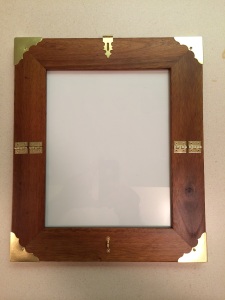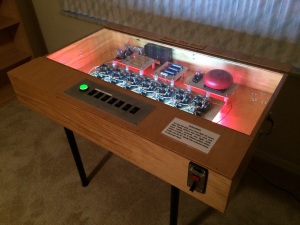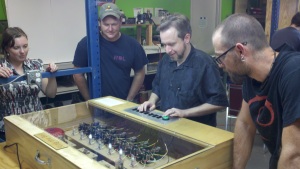I received an honorable mention for this project in Parallax’s 2010 RF Design Contest. Apparently only the 1st-4th place projects are still featured on their website, so I am posting my report here.
Oct 19
Ring the Bell: Introduction
This is probably why you came to my site. Ring the Bell is without a doubt the largest, most complex, most time-consuming project of my hobby career. There is a story behind pretty much every feature, and I will be covering them all in due time. I will chronicle the development of this project to its current state, as well as post updates as I continue to make improvements. In this post I will explain what Ring the Bell is, why I built it, and where I’m going with this project.
Ring the Bell is a unique gaming experience. It challenges the player to solve a puzzle by actually manipulating an electrical circuit. The player uses rocker switches to control a bank of electromechanical relays. The player can see how his or her actions change the circuit as the relay contacts open and close, and indicator lights turn on and off. The relays are staged such that the player’s ability to control a given stage is determined by the state (on/off) of the previous stages. The goal is to turn every stage on, thus completing the circuit to a fire alarm bell. Players compete for the shortest time to completion, and the best times are displayed on the high score board.
Back in the fall of 2010, I was really into puzzle-solving. I was investigating the Hexadecimal Puzzle when I learned that its inventor, William Keister, had developed an electrical version of the puzzle using nothing but relays and switches. I was immediately intrigued, because while I knew that relays were the basis of logical circuits before the advent of transistors, I didn’t realize they could be used to create something complex enough to be considered a puzzle. I was not able to find Keister’s schematic, but I did find an article by A. H. Beiler describing an electrical version of the Chinese Ring Puzzle, from which the Hexadecimal Puzzle and several of Keister’s other designs are derived.
I had never heard of anything like it in either my gaming or engineering circles, so I really wanted to add this puzzle to my collection. However, I had a problem: the relays I was aware of at the time were very compact, which made it difficult to see what connections were being made. The hallmark of a good puzzle is that the player can see how his or her actions affect the mechanism of the puzzle. So I shelved the idea and went on to other projects. Then, in the spring of 2011, I was walking through Fry’s Electronics when I found the answer to my dilemma: a large, contactor-type relay. All of its connections were visible, but it was also significantly larger than the other relays I had been using. A puzzle built from these relays would be enormous, and probably have to be AC-powered, thus rendering it immobile. How, then, would I present it to people to solve? Suddenly, I realized there was a forum for people to play large game machines: the video game arcade!

Both of these relays are double-pole, double-throw (DPDT), which is only apparent for the one on the right.
I started developing my arcade machine during that summer, but due to the number of creative decisions required, as well as my other life commitments, it sat on the back burner for a long time. Then in the fall of 2012, as the Mayan Apocalypse drew near, I reflected on what I had done with my life up to that point and what I wish I had done differently. I found I was pretty happy with my familial, educational, and career situations. Strangely, the only thing I would have changed is that I would have finished my arcade machine. So, as a Mayan New Year’s Resolution, I vowed to finish it. Rather than ponder the possibilities, I would make decisions that would get me to a working prototype. By Mid-March of 2013, I had the electromechanical puzzle itself working. By summer’s end, I had completed the electrical and mechanical integration. After putting the finishing touches on the firmware, I presented Ring the Bell at my then-local maker space, CreatorSpace, on September 24, 2013.
I have made several minor improvements since then, including adding internal lighting and detachable legs. I also plan to remake the switch plate so that the center switch is aligned with the center relays, and to get the coin mechanism working. I have ideas for the next generation of relay-based puzzle, such as one that can be reconfigured to offer players new challenges (I think I know how Keister did it), and also some sort of multiplayer game, but those are further off.
“Completing” Ring the Bell has been one of the most rewarding experiences of my life. I’ve started or wanted to start many projects, but few get started and fewer get finished. I completed this project through sheer willpower, backed by the belief that it was original and worth completing, and a lot of help from my friends. I hope you learn something here at Knickknackatory as I recount my journey with Ring the Bell and my other projects, be it technical know-how, or just expanding your awareness of what is possible.
Oct 09
We Are Under Construction
Hi! I’m just starting to build my site. Please excuse the mess. I will be adding more stuff shortly, so please come back.

 –
–

